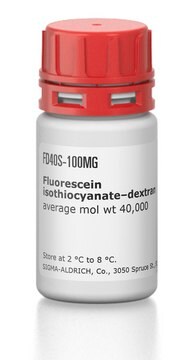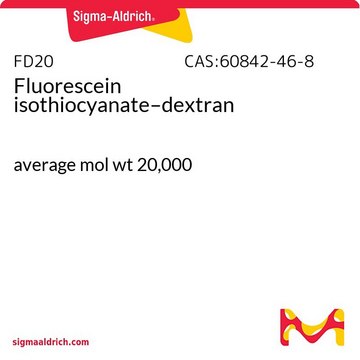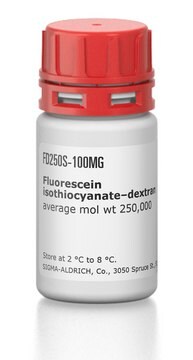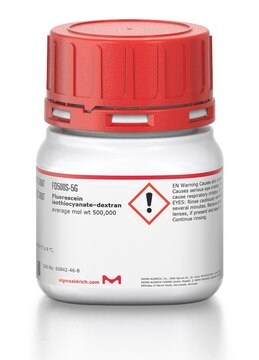FD20S
Fluorescein isothiocyanate–dextran
average mol wt 20,000
Synonym(s):
FITC–Dextran
Sign Into View Organizational & Contract Pricing
All Photos(3)
About This Item
Recommended Products
biological source
sugar beets root
Quality Level
conjugate
FITC conjugate
form
powder
mol wt
average mol wt 20,000
extent of labeling
0.003-0.020 mol FITC per mol glucose
color
yellow to dark yellow
solubility
water: 25 mg/mL
storage temp.
2-8°C
Looking for similar products? Visit Product Comparison Guide
General description
Dextran is a polymer of anhydroglucose. It is composed of approximately 95% alpha-D-(166) linkages. The remaining (163) linkages account for the branching of dextran. Conflicting data on the branch lengths implies that the average branch length is less than three glucose units. However, other methods indicate branches of greater than 50 glucose units exist. Native dextran has been found to have a molecular weight (MW) in the range of 9 million to 500 million. Lower MW dextrans will exhibit slightly less branching and have a more narrow range of MW distribution. Dextrans with MW greater than 10,000 behave as if they are highly branched. As the MW increases, dextran molecules attain greater symmetry. Dextrans with MW of 2,000 to 10,000, exhibit the properties of an expandable coil. At MW below 2,000, dextran is more rod-like. The MW of dextran is measured by one or more of the following methods: low angle laser light scattering, size exclusion chromatography, copper-complexation and anthrone reagent colorometric reducing-end sugar determination and viscosity.
Application
Dextran labeled with fluorescein isothiocyanate for possible use in perfusion studies in animals.
FITC-dextran is used extensively in microcirculation and cell permeability research utilizing microfluorimetry. FITC-dextran has been used to study plant cell wall porosity and capillary permeability. Plasma proteins have been shown not to bind to FITC-dextran.
FITC-dextran is used in cardiovascular, microcirculation, perfusion, cell monolayer and cell membrane permeability research as fluorescent flux tracer compound that supports the measurement of processes such as blood flow, membrane damage, vascular drainage and renal elimination. Small FITC-dextrans are also used to measure processes such as endocytosis and cell junction permeability. Fluorescein-dextran, 20 kDa, may be used to study cell processes such as endocytosis and osmoporation. FITC-dextran-20 may be used to study endothelial or epithelial monolayer porosity, apical-basolateral movements within cell layers and cell junction permeability. FITC-dextran-20 may be used as a model compound to study drug release from structures such as hydrogens and collagen minirods.
Linkage
Similar to FD-20, but produced by Sigma.
Preparation Note
Sigma typically tests the solubility of FITC dextrans in water at concentrations at or above 25 mg/ml. Solutions should be protected from light. In vivo, FITC-dextran is stable for more than 24 hours.
Other Notes
To gain a comprehensive understanding of our extensive range of Dextrans for your research, we encourage you to visit our Carbohydrates Category page.
Signal Word
Warning
Hazard Statements
Precautionary Statements
Hazard Classifications
Eye Irrit. 2 - Skin Irrit. 2 - STOT SE 3
Target Organs
Respiratory system
Storage Class Code
11 - Combustible Solids
WGK
WGK 3
Flash Point(F)
Not applicable
Flash Point(C)
Not applicable
Personal Protective Equipment
dust mask type N95 (US), Eyeshields, Gloves
Choose from one of the most recent versions:
Already Own This Product?
Find documentation for the products that you have recently purchased in the Document Library.
Customers Also Viewed
Marcia Regina da Silva Pedrini et al.
Applied microbiology and biotechnology, 98(3), 1271-1280 (2013-12-10)
Internalization of hydrophilic molecules into yeast cytosol is required for different applications such as cell transformation or preservation of water soluble components by bioencapsulation. However, these molecules are not able to cross the plasma membrane and strategies have to be
Iris Metzmacher et al.
European journal of pharmaceutics and biopharmaceutics : official journal of Arbeitsgemeinschaft fur Pharmazeutische Verfahrenstechnik e.V, 67(2), 349-360 (2007-04-06)
A drug delivery system, named minirod, containing insoluble non-cross-linked collagen was prepared to investigate the release of model drug compounds. To characterise the complete drug release process properly, a mathematical model was developed. Previously, a mathematical model describing water penetration
Damia Mawad et al.
International journal of pharmaceutics, 366(1-2), 31-37 (2008-09-24)
Injectable hydrogels have potential biomedical applications ranging from tissue fillers to drug delivery vehicles. This study focussed on evaluating the structure of poly(vinyl alcohol) (PVA) hydrogels of variable solid content and high molecular weight model drug release from the networks
Kaushik Parthasarathi
American journal of physiology. Lung cellular and molecular physiology, 303(1), L33-L42 (2012-05-09)
Acid aspiration, a common cause of acute lung injury, leads to alveolar edema. Increase in lung vascular permeability underlies this pathology. To define mechanisms, isolated rat lungs were perfused with autologous blood. Hydrochloric acid and rhodamine-dextran 70 kDa (RDx70) were
Sunali Bhatnagar et al.
Journal of pharmaceutical sciences, 103(6), 1903-1912 (2014-04-11)
Ultrasound (US) exposure of soft tissues, such as the skin, has been shown to increase permeability, enhancing the passage of drug molecules via passive processes such as diffusion. However, US regimes have not been exploited to enhance active convective transport
Our team of scientists has experience in all areas of research including Life Science, Material Science, Chemical Synthesis, Chromatography, Analytical and many others.
Contact Technical Service











